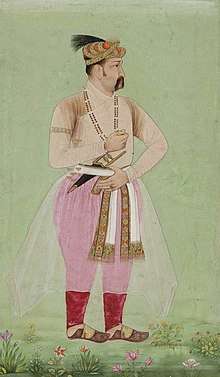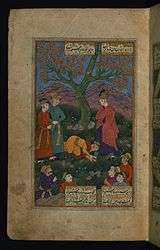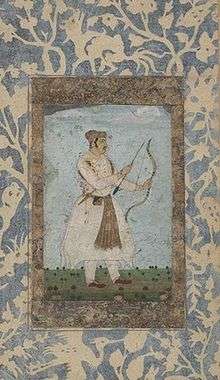Daniyal Mirza
| Daniyal Mirza | |||||
|---|---|---|---|---|---|
| Shahzada of the Mughal Empire | |||||
 | |||||
| Born |
11 September 1572 Ajmer, Rajasthan | ||||
| Died |
19 March 1605 (aged 32) Burhanpur, Maharashtra | ||||
| Burial | Sikandra, Agra | ||||
| Spouse |
Janan Begum Sultan Begum Five other wives | ||||
| Issue |
Tahmuras Mirza Baysunghar Mirza Hoshang Mirza Sa'adat Banu Begum Mahi Begum Bulaqi Begum Burhani Begum | ||||
| |||||
| Dynasty | Timurid | ||||
| Father | Akbar | ||||
Daniyal Mirza (11 September 1572 – 19 March 1605[1]) was an Imperial Prince of the Mughal Empire who served as the Viceroy of Deccan. He was the third son of Emperor Akbar the Great and the brother of the Emperor Jahangir.
Life

He was made the Subahdar (Governor) of the Deccan from 21 April 1601 to April 1604. He was appointed to an Imperial mansab of 7,000 soldiers.
Family
His mother
The name of Daniyal's mother is not stated in the Akbarnama.[2] The Tuzk-e-Jahangiri identifies her, along with the mother of Sultan Murad, as royal concubines.[3]
The Tawarikh-i-Selim, an unverified purported autobiography of Jahangir, names her as one 'Bibi Mariam' (not to be confused with Mariam uz-Zamani).[4]
Orientalist Henry Beveridge believed, given that Daniyal was fostered with the wife of Raja Bihar Mal, that the Prince was related to her through his mother.[5] The mother cannot, however be identified with the Empress Mariam uz-Zamani, the daughter of Bihar Mal and mother of Jahangir as Daniyal's mother died in 1596, while Mariam uz-Zamani lived long into the reign of her son.[6][7]
Anarkali
William Finch, an English traveler to the Mughal Court in 1611, visited what he believed to be the tomb of Daniyal's mother, whom he referred to as Anarkali. Finch stated that after Anarkali, who was Akbar's favourite concubine, was discovered to be having an affair with the then Prince Selim (Jahangir), Akbar had her sealed alive within a wall as punishment. Finch then continued that upon coming to the throne, Jahangir had the tomb erected in her memory.[8] The following Persian couplet, composed by Jahangir is inscribed on her sarcophagus:[9]
| “ | Oh, could I behold the face of my beloved once more, I would give thanks to my God until the day of resurrection. | ” |
The story was later romanticised into the modern legend commonly referred to as Selim and Anarkali.
Alternatively the 18th century historian Abdullah Chaghtai states that the tomb belonged to Sahib i-Jamal, a wife of Jahangir who died in 1599. He further suggests that the tomb was mistakenly associated with Anarkali (literally meaning pomegranate blossom) due to the Bagh i-Anaran (Pomegranate Garden) that once grew around it.[10]
Marriages

Daniyal's first wife was the daughter of Sultan Khwajah. The marriage took place on 10 June 1588 in the house of Daniyal's grandmother, Empress Hamida Banu Begum.[11] She was the mother of a daughter born on 26 May 1590,[12] and another daughter Sa'adat Banu Begum[1] born on 24 March 1592.[13] His second wife was the daughter of Qulij Khan Andijani. Akbar had intended that Qulij's daughter should be married to Daniyal. On 27 October 1593 the grandees were assembled outside the city, and the marriage took place. It occurred to Qulij Khan that Akbar might visit his house. In gratitude for this great favor he arranged a feast. His request was accepted and on 4 July there was a time of enjoyment.[14] She was the mother of a son born on 27 July 1597 and died in infancy,[15] and a daughter Bulaqi Begum.[1] She died near Gwalior on 12 September 1599.[16]
His third wife was Janan Begum, the daughter of Abdurrahim Khan-i Khanan. The marriage took place in around 1594. Akbar gave a great feast, and received such a quantity of presents of gold, and all sorts of precious things, that he was able to equip the army thereform.[17] She was the mother of a son born on 15 February 1602 and died soon after.[18] The prince was extremely fond of her, and after his death in 1604, she led a life full of sorrow.[1]
His fourth wife was the daughter of Rai Mal, the son of Rai Maldeo, ruler of Jodhpur. The marriage took place on the eve of 12 October 1595.[19] Danyal's fifth wife was the daughter of Raja Dalpat Ujjainiya. She was the mother of Prince Hoshang Mirza born in 1604,[20] and of Princess Mahi Begum.[1] Another of his wives was the mother of Prince Tahmuras Mirza, Prince Baisungar Mirza born in 1604,[21] and Princess Burhani Begum.[1]
His seventh wife was Sultan Begum, the daughter of Ibrahim Adil Shah II, ruler of Bijapur.[22] He had requested that his daughter be married to Daniyal. His request was accepted, and on 19 March 1600, Mir Jamal-ud-din Hussain was sent off with the arrangements of the betrothal. When he came to Bijapur, Adil treated him with honor. After over three years he sent him away with his daughter, and Mustafa Khan as her vakil. When Abdul Rahim Khan heard of her arrival he sent his son Mirza Iraj to meet her. Mirza Iraj brought her to Ahmadnagar. Mir Jamal-ud-din hastened off from there and went to the prince in Burhanpur. Daniyal accompanied by Abdul Rahim, came to Ahmadnagar. The marriage took place on 30 June 1604.[21]
Daniyal's eldest son Tahmuras Mirza was married to Bahar Banu Begum, daughter of Jahangir, and his second son Hoshang Mirza was married to Hoshmand Banu Begum, the daughter of Khusrau Mirza.[23]
Death and fate of his sons
Prince Daniyal was addicted to alcohol and died of alcoholism on 11 March 1605, aged 33, as Abu l-Fazl writes in the Akbarnama.[24] He left three sons and four daughters.[25] His son, Prince Hoshang, was married to Hoshmand Banu Begum, the daughter of Prince Dawar.[26]
When his nephew Shah Jahan had seized the throne on Jumada-l awwal 2, 1037 AH (30 December 1627[27]), he had Daniyal's two sons, Tahmuras and Hoshang, sent "out of the world" on 23 January 1628. They were executed together with Daniyal's younger nephew Shahryar, who had been Queen Nur Jahan's favourite for the throne, with Shahryar's two sons, and with the puppet emperor Dawar, whom the vizier Asaf Khan had crowned as a placeholder until Shah Jahan had arrived.[28] [29]
References
- 1 2 3 4 5 6 Beveridge 1907, p. 1254.
- ↑ Henry Beveridge, Akbarnama of Abu'l Fazl Volume II (1907), p. 542
- ↑ transl.; ed.,; Thackston, annot. by Wheeler M. (1999). Tuzk-e-Jahangiri : Memoirs of Jahangir, Emperor of India. New York [u.a.]: Oxford Univ. Press. p. 37. ISBN 9780195127188.
- ↑ Major David Price, Memoirs of the Emperor Jahangueir (1829), p. 46
- ↑ Henry Beveridge, Akbarnama of Abu'l Fazl Volume II (1907), p. 543
- ↑ Henry Beveridge, Akbarnama of Abu'l Fazl Volume III (1907), p. 1063
- ↑ Henry Beveridge, Alexander Rogers, The Tūzuk-i-Jahāngīrī, Volume II (1909), p. 261
- ↑ Samuel Purchas, Purchas his pilgrimes, Volume I (1625), p. 433
- ↑ Syad Muhammad Latif, Lahore: Its History, Architectural Remains and Antiquities: With an Account of Its Modern Institutions, Inhabitants, Their Trade, Customs, &c (1892), p. 186
- ↑ Shaikh Khurshid Hasan, 8.The Islamic Architectural Heritage of Pakistan: Funerary Memorial Architecture (2001), p. 117
- ↑ Beveridge 1907, p. 806.
- ↑ Beveridge 1907, p. 875.
- ↑ Beveridge 1907, p. 937.
- ↑ Beveridge 1907, p. 995.
- ↑ Beveridge 1907, p. 1090.
- ↑ Beveridge 1907, p. 1139.
- ↑ `Abd al-Qadir Bada'uni (1884). Muntakhab-ut-Tawarikh - Volume II, translated by W.H. Lowe. Calcutta, Asiatic Society of Bengal. p. 403.
- ↑ Beveridge 1907, p. 1200.
- ↑ Beveridge 1907, p. 1040.
- ↑ Beveridge 1907, p. 1238.
- 1 2 Beveridge 1907, p. 1239–40.
- ↑ Nāzim, Muhammad (1936). Bijapur inscriptions. Manager of publications. p. 110.
- ↑ Jahangir, Emperor; Thackston, Wheeler McIntosh (1999). The Jahangirnama : memoirs of Jahangir, Emperor of India. Washington, D. C.: Freer Gallery of Art, Arthur M. Sackler Gallery, Smithsonian Institution; New York: Oxford University Press. p. 436.
- ↑ Abu l-Fazl b. Mubarak: The Akbar Nama of Abu l-Fazl, tr. H. Beveridge, Delhi: Low Price Publications, 2010 vol. 2, p. 1254. Online at the Packard Humanities Institute.
- ↑ Ibid.
- ↑ The Grandees of the Empire Ain-i-Akbari, by Abul Fazl. Volume I, Chpt. 30.
- ↑ Taylor, G.P. (1907). Some Dates Relating to the Mughal Emperors of India in Journal and Proceedings of the Asiatic Society of Bengal, New Series, Vol.3, Calcutta: The Asiatic Society of Bengal, p.59
- ↑ Death of the Emperor (Jahangir) The History of India, as Told by Its Own Historians. The Muhammadan Period, Sir H. M. Elliot, London, 1867–1877, vol 6.
- ↑ Majumdar, R.C. (ed.)(2007). The Mughul Empire, Mumbai: Bharatiya Vidya Bhavan, pp. 197–8
Bibliography
- Beveridge, Henry (1907). Akbarnama of Abu'l-Fazl ibn Mubarak – Volume III. Asiatic Society, Calcuta.
External links
| Wikimedia Commons has media related to Daniyal Mirza. |